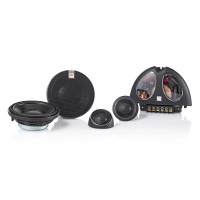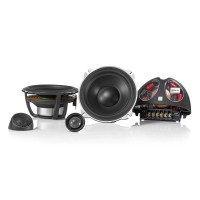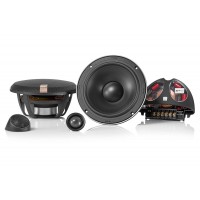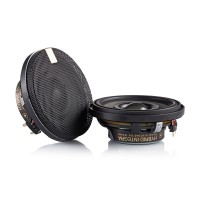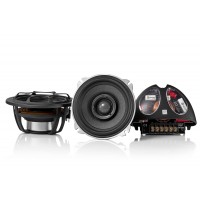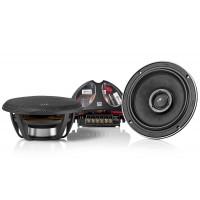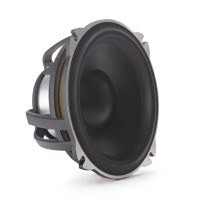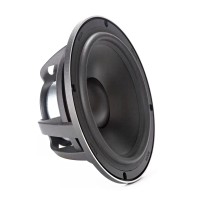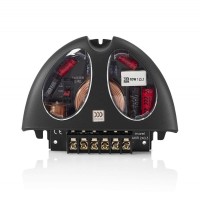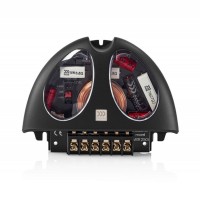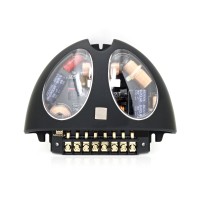Morel Hybrid 63 speakers
More about the product
- Use our consulting room
- You can return the goods to us within 14 days
- Try the product at our store
Morel Hybrid 63 speakers
The latest 3-band hybrid system featuring Morel's legendary craftsmanship, engineering and innovation. They define the ever-evolving concept of Morel Hybrid loudspeaker design. The updated Hybrid and Hybrid Integra series, now in their fifth generation, provide an even more perfect listening experience and captivate you with raw live music. Their fine balance of resolution, performance and efficiency has been further optimized to exceed expectations no matter what genre of music you enjoy. Now the Hybrid is available in 2-way and Integra coaxial systems, as well as a new 3-way system to suit almost any high-quality music requirement.
EVC™ system
Morel speakers with EVC™ technology use voice coils that are up to three times larger than conventional speakers. The EVC™ design moves the magnetic drive system inside the voice coil and eliminates stray magnetic flux by effectively directing all magnetic energy into the voice coil. The result is an ultra efficient and powerful system that is highly compact with efficient heat dissipation and reduced membrane breakdown for less distortion.
Handmade Morel Acuflex membranes
A specially developed damping compound applied to the soft domes of specific Morel tweeters and center speakers. The combination of silk and paper materials creates a membrane that exhibits controlled decay cancellation (flexion, to be exact), meaning that each decay mode is suppressed by another in the opposite direction. This cancellation of decay modes leaves nothing but the clean and natural sound that Morel tweeters and midrange speakers are known for.
CAR filter - acoustic cooling
CAR is controlled acoustic resistance. In most automotive applications, loudspeakers are installed in a virtual space such as a door to ensure minimal acoustic load. The CAR Filter™ improves the acoustic load by controlling the airflow inside the speaker, resulting in improved power control by up to 30%. This provides more control over the movement of the diaphragm for better bass dynamics.
HEXATECH™ aluminum voice coil
Made from 100% aluminum honeycomb wire, the Hexatech™ voice coil reduces air gaps in the coil winding, increasing efficiency by up to 20%. Being lightweight, the Hexatech™ coils are largely responsible for the ultra-quick transient response Morel drive units are known for.
DPC mid-bass membrane
DPC (or Damped Polymer Cone) is a direct derivative of the membranes on which Morel has built its reputation. Thanks to its high auto-damping characteristics, this diaphragm provides exceptional sound quality without coloration or harshness.
Hybrid magnetic drive
The hybrid drive system uses a ferrite magnet along with a very powerful neodymium magnet. Combined, they create a compact and lightweight system that is up to four times more powerful than conventional designs of the same size. With a hybrid system, more of the amplified power is converted to sound energy for flawless performance, even in a small driver.
| Catalog number | HYBRID 63 |
| Brand | Morel |
| Links | Official web presentation |
| Speaker typeCoaxial speakers: Coaxial speakers are characterized by a so-called all-in-one design. The tweeter and mid-bass speaker are in one basket. The advantage is simpler assembly, but thanks to the connection or proximity of the bands in one speaker, the sound quality will usually be reduced. As a rule, in the middle of the mid-bass speaker, there is a tweeter whose voice coil works in the second air gap of the common magnetic circuit. The three-way coaxial speaker consists of a mid-bass speaker, a center speaker and a separate tweeter in the front on a special beam. Component Speakers: Component speakers are characterized by a division into individual frequency bands, treble + mid-bass + or. bass band. The individual speakers can be placed completely separately, which results in a better sound and acoustic performance. In the vast majority of cases of component speakers, an external crossover is also supplied, which divides the treble, middle / mid-bass, and into the three-band the bass band or allows setting the decibel level of the tweeter (e.g. +2 dB, 0 dB, -2 dB), steepness (e.g. 6dB/Oct. 12dB/Oct.) or active or bi-amp connection. | Komponentní 3pásmové |
| RMS powerRMS speaker power is the constant power of the entire system, not just one speaker or one side. This is also the performance of continuous use of the speakers. If the RMS power is exceeded for a long time, the speakers may be irreversibly damaged! | 140 W |
| Max. (maximum performancePeak performance , which the speaker can play for a moment (approx. 0.5 s), for example when hitting drums in a song. If the max power is exceeded, the speakers will usually be damaged! | 600 W |
| Sensitivity (SPL 2.83V/1m)Sensitivity, sensitivity or efficiency of the speaker. Speaker sensitivity is given in decibels (dB) and simply put, the higher the value, the lower the demands on the amplifier's power. This is a defacto rating of how a speaker converts watts to sound. Sensitivity ratings are in noise level measured at 1 meter from the speaker using 1 W (watt of power) or using 2.83 volts at the source at 1 meter. A higher decibel level means the speaker is louder with less power. For every 3 dB increase in sensitivity, the speaker requires half the power to reproduce the same volume. For example, if an 88 dB speaker needs 100 Watts to produce a certain volume, then a speaker with a sensitivity of 91 dB needs only 50 Watts to reach the same volume. | 91 dB |
| ImpedanceImpedance - measurement of electrical resistance. When buying speakers, it is important to make sure that the impedance matches the amplifier or car stereo you are using. Example: A 2 Ohm speaker cannot be connected to an amplifier that is only stable up to 4 Ohms! A 4 Ohm speaker can easily be used with an amplifier that is stable up to 2 Ohms. The most common speaker impedance today is 3 - 4 Ohm. | 4 Ω |
| Frequency rangeThe ability of the speakers to play a signal from the lowest frequency to the highest, or the speaker's ability to faithfully reproduce sound in a specific frequency band. Professionally: In the frequency range from 40 to 16,000 Hz, the vast majority of fundamental and overtones (harmonics) of all musical instruments are found. We are interested in the course of the radiated sound pressure in this range of frequencies when the loudspeaker system is supplied with constant power. We call this course the frequency characteristic, which tells us the level of radiated sound pressure in decibels (dB) depending on the frequency. The frequency characteristic of a speaker or speaker system can be expressed most succinctly with a graph. Mostly, however, the frequency characteristic is indicated by indicating the maximum tolerance of the sound pressure in the given frequency range, e.g. 50 to 15,000 Hz -+ 6 dB. Since the frequency characteristics of loudspeakers and systems in general are quite uneven, some manufacturers do not even specify this maximum tolerance of sound pressure in decibels in their catalogs for reasons of prestige. Data impoverished in this way is unfortunately worthless. What is valid is that the manufacturer offers a speaker system with a frequency range of 30 to 20,000 Hz, if he is worried about stating the maximum unevenness of the sound pressure in this range, because he can have a tolerance of, for example, +- 20 dB. The unevenness or undulation of the frequency curve in good speaker systems for high-quality music performance should not exceed +-3 dB in the 80 to 12,000 Hz band and +-6 dB in the 40 to 16,000 Hz band. Greater unevenness already depletes or emphasizes certain tonal areas, which can cause audible or even disturbing distortion. The proportion between fundamental tones and higher harmonics also changes, thereby changing the color of the sound, and individual musical instruments as well as the entire musical image sound unnatural. | 35 - 25000 Hz |
| The diameter of the mid-bass speakerWe state the diameter of the speaker as the diameter of the entire speaker, not including the mounts, when smaller speakers (87, 100, 130 mm) have extra mounts. Some speakers are oval and there the dimension is given in inches, always the shortest side to the longest side. One inch is approx. 2.5 cm. | 165 mm |
| Installation depth of the mid-bass speakerThe installation depth of the speaker is measured from the bottom edge of the magnet to the bottom edge of the tin, plastic or cast speaker basket, or speaker bearing surfaces. | 61 mm |
| Center speaker diameterThe diameter of the center speaker is given as the diameter of a round speaker, not including the mount, where the mounts protrude even more on smaller speakers. | 75,5 mm |
| Mounting depth of the center speakerThe mounting depth of the center speaker is measured from the bottom edge of the magnet to the bottom edge of the tin, plastic or cast speaker basket. | 21 mm |
| Tweeter dome diameterThe net diameter of the dome (diaphragm) of the tweeter. | 28 mm |
| The overall depth of the tweeterThe total depth of the tweeter itself without the installation houses. | 20 mm |
| Tweeter dome materialThe shell material that was used in the manufacture of the tweeter. | Hedvábí potažené Acuflexem |
| Frequency crossover included in the packageThe crossover is an important part of defacto all loudspeakers. A crossover usually contains different resistor values, coil sizes, and capacitor types that fundamentally modify the sound. We describe below what the turnouts are for. Component Speakers: A crossover is part of every quality component speaker system. Its task is to ensure the distribution of frequencies that the amplifier produces in the entire acoustic spectrum of frequencies so that each of the speakers receives only that part of the band that it can optimally play in terms of efficiency and minimal distortion. Coaxial speakers: In most cases, coaxial loudspeakers have a simple crossover (6dB/Oct.) formed by a capacitor at the tweeter. | Ano (plnohodnotná) |
| Options for setting the frequency crossoverThe unwritten rule is that the more expensive the speakers, the more options the crossover has for adjusting the sound. The most common way to adjust the crossover is attenuation on the tweeter. More advanced crossovers also offer the option of setting the steepness on the mid-bass and tweeter or adjusting the frequency range. | Ano (Tweeter -4, -2, 0 dB) |
| Cover grids included in the packageOriginal cover grilles in speaker packaging. | Ano |
| Price forIf the price is for a pair, the package always includes 2 pieces of everything, e.g. 2x mid-bass, 2x tweeter and 2x crossover. | Pár |


